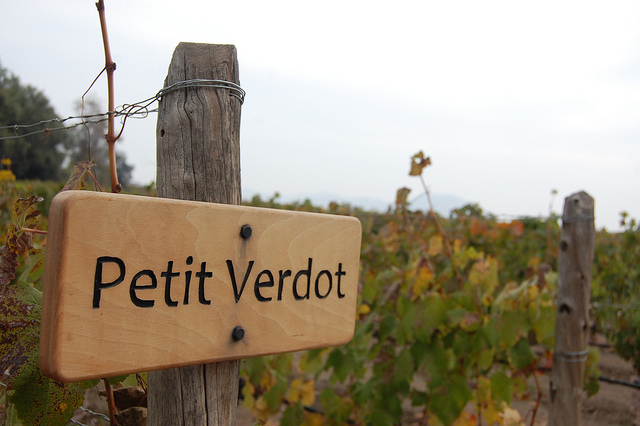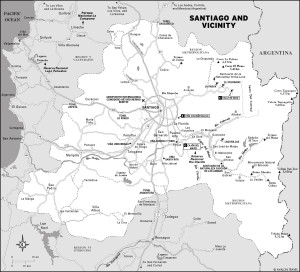
Viña Concha y Toro. Photo © Carlos Varela, licensed Creative Commons Attribution.

Santiago and Vicinity
Barely an hour southeast of downtown Santiago, the Río Maipo has cut a deep canyon through more than 70 kilometers of the Andean foothills before it meanders onto the plains near the town of Pirque. Once the border of the Kollasuyu, the Inka empire’s southernmost limits, the Cajón del Maipo (Canyon of the Maipo) is one of urban Santiago’s great escapes, barely an hour from the Plaza de Armas.Starting with fine wineries at Pirque and Santa Rita, the canyon just gets better as it climbs toward the Andean crest. While parts of the main road are cluttered with cabañas, campgrounds, and restaurants, it still provides access to plenty of high and wild country, not to mention the river itself. Paved as far as Romeral, it and a parallel road from Pirque are good enough for road bikes, but other routes are suitable for mountain bikers, and hikers and horseback riders can explore the trails of Monumento Natural El Morado and the private nature reserve Cascada de las Ánimas.
The Class III–IV Río Maipo provides plenty of thrills for rafters and kayakers, even though diversions for irrigation works and even more from sand and gravel quarrying have taken their toll. At day’s end, rustic hot springs are suitable for a soak. While the area gets crowded in summer and on weekends and holidays, especially from December to March, the rest of the year it’s pretty sedate.
Transportation to the Cajón del Maipo is good and getting better—though perhaps not so interesting as when, half a century ago, a military train carried passengers from Puente Alto to El Volcán. From the Puente Alto Metro station, Buses Cajón del Maipo (tel. 02/8611518) ascend as far as San José de Maipo every eight minutes, to San Alfonso (US$2) every half hour, and to San Gabriel (US$3) hourly. From the Bellavista de La Florida station, it also goes to Baños Morales (US$12 round-trip) Saturday and Sunday at 8:30 a.m. all year; in summer, departures are daily. Taxi colectivos also shuttle up and down the canyon from the Puente Alto Metro.
Viña Santa RitaBernardo O’Higgins and 120 of his troops hid from the Spaniards in the catacombs at Hacienda Santa Rita (Camino Padre Hurtado 0695, Alto Jahuel, tel. 02/3622594, [email protected], tours 11:30 a.m. and 4 p.m. Tues.–Fri., US$19 pp), a distinguished winery that named its main line of wines—120—after the event. Today, its main house is a hotel, the former colonial house (a national monument) is a restaurant, and the grounds and cellars (also a national monument) are open for tours (includes a tasting). Tours are free with lunch at La Casa de Doña Paula (tel. 02/3622520, 12:15–3:30 p.m. daily, US$25), but do not include sampling the produce.
Open by reservation only Santa Rita’s 16- room Hotel Casa Real (tel. 02/8219966, [email protected], US$390–430 s or d) normally takes groups occupying at least five rooms. On a space-available basis, though, they will accept individuals or couples. Though it’s not quite in the Cajón del Maipo proper, Viña Santa Rita is part of the Maipo drainage, east of Buin and southwest of Pirque; buses from Pirque to Buin pass the front gates. For obligatory reservations, contact them at least a few days in advance.
Recently, Santa Rita has added a Museo Andino (Andean Museum, 10:30 a.m.–5 p.m. Mon.–Sat., free). Oddly, given the name, it includes an Easter Island exhibition.
Viña Concha y Toro and Vicinity
On the Maipo’s south bank, 30 kilometers from Santiago, Pirque is a tranquil community that’s resisted the cookie-cutter suburbanization that mars much of southeastern Santiago. Its key attraction is Viña Concha y Toro (Victoria Subercaseaux 210, tel. 02/4765269, tours 10 a.m.–5:10 p.m. daily, US$17 pp), one of Chile’s largest and oldest wineries, but it also boasts a weekend crafts fair and is the starting point for a scenic but narrow paved road that climbs the canyon before rejoining the main road via a bridge at El Toyo.
Viña Concha y Toro offers guided tours (includes a tasting) of its vineyards, estate grounds, cellars, and museum. Spanish-language tours take place 10:30 a.m., 11 a.m., noon, and 4 p.m. daily; some are specifically for English speakers, but bilingual guides can often do both languages simultaneously. While reservations are desirable, it’s possible to join an existing group that might include—who knows?—figures such as Mick Jagger, Bono, Helmut Kohl, Nicaraguan poet Ernesto Cardenal, and others who have toured the grounds and sampled the results. Concha y Toro now has its own wine bar that serves tapas, cheeses, and a few more elaborate Chilean dishes.
Reserva Nacional Río Clarillo
In the precordillera southeast of Pirque, Reserva Nacional Río Clarillo (US$6 pp) is a 10,185-hectare unit of glossy-leaved Mediterranean scrub woodland, plus denser gallery forest along the course of its namesake river, a Maipo tributary. While Conaf does not allow camping here, it does permit picnicking and hiking.
Two short nature trails have interpretive panels: the 1.2-kilometer Sendero Interpretativo Quebrada Jorquera and the 1.7-kilometer Sendero Interpretativo Aliven Mahuida, a more biologically diverse path.
Reserva Nacional Río Clarillo is 45 kilometers southeast of Santiago and 18 kilometers from Pirque.
Reserva Nacional Río Clarillo
At the western approach to the main road up the north side of the Cajón del Maipo, just beyond the Carabineros police post at Las Vizcachas, note the informal shrine for the folk saint Difunta Correa, strongly identified with Argentina’s San Juan province but with a distinctly binational twist here. According to legend, the young mother Deolinda Correa died of thirst in the desert in the 19th century, but her baby survived at her breast; her need for water explains the bottles left by her devotees.
On the south side of the highway, a bit farther on, Vinícola Cavas del Maipo (tel. 02/8711508, 9 a.m.–4 p.m. daily, tours US$10) offers guided winery tours by reservation only, preferably made a day ahead of time. The generous tasting includes half a dozen samples of their wines, accompanied by cheese and crackers.
La Obra
A short distance east of Las Vizcachas, 790 meters above sea level, La Obra was a stop on the military railroad that once climbed from Puente Alto to El Volcán; its Estación La Obra is a national monument.
Just east of La Obra, the rise known as Cuesta las Chilcas was the site of the Frente Patriótico Manuel Rodríguez’s 1986 assassination attempt on General Pinochet as he returned to Santiago from his El Melocotón country house. Five bodyguards died in a hail of bullets and a rocket launcher attack, but his chauffeur’s skilled driving saved the dictator’s life. Pinochet’s admirers have commemorated the event with a monument honoring the bodyguards.
Guayacán
At a bend in the river, a few kilometers north of San José de Maipo, Casa Bosque (Camino El Volcán 16829, tel. 02/8711570, entrées US$12–20) has the most extravagant decor of any Cajón del Maipo restaurant: The twisted trunks of polished cypress that hold it up seem like something from an early Disney misadventure. The simple menu based on beef, plus a few chicken and pork dishes, doesn’t match the imaginative architecture. Still, Casa Bosque is worth seeing for the spectacle; it has recently added an 18-room hotel whose interior is less preposterous than the restaurant.
San José de Maipo
The canyon’s largest town, 967 meters above sea level, San José is about 25 km up the canyon from Puente Alto. It has a leafy Plaza de Armas focused on its Iglesia y Casa Parroquial, a national monument dating from late colonial times. Its former Estación de Ferrocarril, also a national monument, was a stop on the military railroad from Puente Alto to El Volcán.
El Melocotón
About five kilometers south of San José de Maipo, El Melocotón is most famous—or notorious— as the site of General Pinochet’s riverfront home (the first recreational kayakers to descend the Maipo, in the 1970s, faced automatic rifles pointed at them from the shore). It briefly made the news again in 2001 when it was discovered that a former FPMR guerrilla had rented a house just a few hundred meters from the general’s residence.
San Alfonso
San Alfonso, about six kilometers southeast of El Melocotón and 1,106 meters above sea level, made news in 1997 when local residents successfully forced relocation of a natural gas pipeline from Argentina by establishing a private nature reserve at Cascada de las Ánimas. A short distance up a tree-lined dirt road before the entrance to Cascada de las Ánimas, look for the scale miniature railway circling the house and gardens of José Sagall (“Pepe Tren”), as well as his assortment of full-scale antique railcars. About 100 meters farther south, the former Estación San Alfonso is a national monument as part of the military short line that also hauled Santiaguinos to their weekend getaways from the capital.
Hotel Altiplánico (Camino al Volcán 29955, tel. 02/8612078, US$230 s, US$320 d) is the latest effort of the boutique hotel chain that now has properties in Puerto Natales, San Pedro Atacama, and Easter Island.
Santuario de la Naturaleza Cascada de las Ánimas
In the midst of a multiyear struggle to divert a natural gas pipeline from Argentina, the Andean precordillera of the Astorga family’s former fundo (large rural estate) Cascada de la Ánimas became one of Chile’s first private nature reserves (Camino al Volcán 31087, San Alfonso, tel. 02/8611303) in 1995. Two years later the owners managed to definitively defeat the pipeline.
In practice, the official designation hasn’t made much difference, but it allows them to continue, without disruption, the activities- oriented recreation that has made the 3,600-hectare property a prime destination for hikers, riders, and especially white-water rafters and kayakers. Descending the Maipo (US$40 pp) is a Class III–IV experience that’s normally suitable for novices, but the river can get wild enough for more experienced whitewater lovers, especially during the spring runoff. Elevations range from about 1,100 meters along the river to 3,050 meters on the highest summit.
Many Santiaguino families come here for picnicking and swimming at Cascada’s large outdoor pool on the river’s more developed north side. In the summer high season, fees are US$16 pp for adults, US$10 for kids; the rest of the year, prices are half.
Most other activities take place on the south side, where the Sendero Cascada de las Ánimas is a short guided hike to its namesake waterfall. More foreigners than Chileans undertake the 2–3-hour guided climb to the summit of Cerro Pangal. While horseback riders will enjoy this scenic terrain, much of it is very steep and novice riders should be particularly cautious. Cascada also offers longer 2–3-day rides into the backcountry.
The campground charges US$20 per person for camping for adults, US$16 for children; after the first night, though, the price drops by 20–25 percent. Cabaña accommodations cost US$100 double, US$150 for up to four people; larger cabañas are also available. These prices include pool access and a guided hike to the waterfall.
In addition, Cascada’s restaurant La Tribu offers a diverse menu ranging from Chilean standards such as cabrito (kid goat) and pastel de choclo, as well as Thai and other international dishes. The new terrace has unobstructed river views.
Excerpted from the Fourth Edition of Moon Chile.